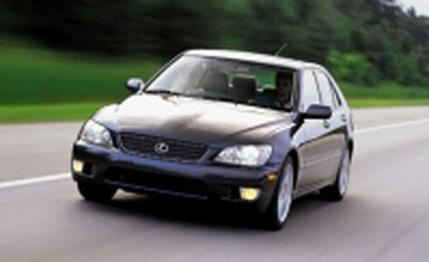
 Road Test
Road Test
Don't bring a knife to a gunfight. That's the advice offered in the movie The Untouchables, and you have to wonder if the guys at Lexus missed that part. The weapon they could have brought to a showdown between their new IS300 and the quick-draw BMW 328i is a manual transmission.
Instead, the IS300 walks Main Street with just a five-shooter automatic in its holster. That's because, in our power-hungry U.S. market, this model gets the brawny 3.0-liter straight-six engine from the GS300. That motor has too much torque for the six-speed stick shift used in the 2.0-liter IS200 model in other markets, so that manual obviously can't be used.
Therefore, we get the GS300's five-speed automatic, along with a similar steering-wheel-mounted pushbutton override system. A manual is on the way, says Lexus, but the immediate lack of a manual gearbox may not be a problem in a certain kind of shootout anyway. Such as in a battle for customers who like the idea of a 3-series-size sport-luxury sedan with an automatic, but who might be swayed by the likely Lexus virtues of slick build quality, certain durability, and low ownership costs.
Similar in size and mission to its German rival the IS300 may be, but it has its own distinctive look as well as a quite different personality. For one thing, Lexus has designed an interior with its own unique flavor.
Eschewing the somewhat stereotypical nature of typical sports sedans, it has adopted a quite quirky instrument panel modeled on the look of a contemporary chronograph wristwatch face.
And where one might expect a leather-wrapped gearshift knob, in the IS300 you find a chrome ball that could be at home in a PT Cruiser. Instead of a monochrome interior, you find titanium strips enclosing the instrument binnacle, surrounding the center console, and forming the surface of the stereo system.
Other design motifs consciously repeated around the car are ribbed indentations found above the dash and echoed in the door moldings and on the gear-selector housing, and oval forms repeated on the gear-selector housing and dashboard vent registers. Our car also wore the stylish optional perforated leather and Escaine (suede) upholstery on seat surfaces and door cappings, which is definitely recommended.
Whatever you think of the IS interior, it's certainly not inspired by the typical Teutonic coal bin. And despite the seemingly eccentric design touches, it is still neutral enough in tone that you don't feel as though you're stuck in an art deco display.
Nonetheless, what you see when you look under the hood is a lot more classical in style. Tidily exhibited there is a sophisticated twin-cam straight-six. Its chief virtue is torque. Lots of it, supplied with an almost soft, creamy delivery that often understates its effect. Mysteriously, traffic always drops away faster than you expect it to.
A careless prod at the accelerator when leaving a stop sign quickly demonstrates how much torque is on tap, as well as how tight the torque-converter calibrations are. It's easy to snap your head back, and you soon learn to toe gently into the throttle for smooth and gradual takeoffs.
For quick sprints to 60 mph, smoothness isn't necessary. With the traction control switched off, the transmission power-mode button depressed, and the car held on the brake briefly at full throttle, our car completed this little task in 7.6 seconds. Which, unfortunately, is 0.5 second slower than Lexus's claim for the feat. Since the company is usually a bit conservative about these things, we're wondering why our car ran slow.
Similarly, our quarter-mile time of 15.9 seconds took 0.6 second longer than what Lexus engineers expected. But less predictable was the fact that the IS300 ran just about exactly the maximum speed claimed for it: 144 mph.